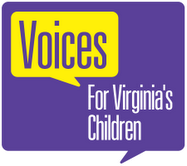Virginia Ranks 13th in Child Well-Being for Second Consecutive Year; Economic Security Improvements Stalled
U.S. Surgeon General Warns of Youth Mental Health Pandemic” in 2022 KIDS COUNT Data Book
RICHMOND — A new report from the Annie E. Casey Foundation ranks Virginia 13th in child well-being. According to the 2022 KIDS COUNT Data Book – a publication analyzing how children and families are faring across all 50 states – Virginia is making slight improvements across all economic indicators, including a 24% reduction in the percentage of children living in households with a high housing cost burden.
“Virginia is moving in the right direction but has been slow to improve progress on family self-sufficiency prior to the pandemic despite our strong economic climate,” said Lauren Snellings, research director at Voices for Virginia’s Children. “Our target must be investing in solutions that reduce childhood poverty and keep families together, especially for children of color.”
“We are positioned to help families gain economic security by continuing to support and expand policies like the Earned Income Tax Credit and Child Tax Credit,” Snellings added. “Virginia must double down on policies and ensure equitable access to child care, quality health care, safe housing and financial opportunities to become a top 10 state.”
Each year, the Data Book presents the latest available national and state data from 16 indicators in four domains — economic well-being, education, health, and family and community factors — and ranks states overall. The data in this year’s report include both pre-pandemic and more recent figures. Here’s where Virginia lands in each domain:
- Economic well-being: Virginia saw improvements in all four indicators compared to 2008-2012. There are 24,000 children fewer children living in poverty and the percentage of children in families with no full-time employment decreased by 8% from 2016-2022. Additionally, the percent of teenagers who are not in school and are unemployed decreased by 29%. However, there are still 242,000 children living below a family income of $26,246.for a family of four.
- Education: Virginia is in the top 10 at 6th place. The percentage of high school students not graduating on time decreased from 18% to 13% (2010-2011 vs. 2018-2019).
- Health: Virginia ranks 24th. The percent of children without health insurance, improved from 7% to 5% from 2008-12 to 2016-20. But that is the only indicator to improve during the trend year. Children born with low birth weight, child and teen deaths, as well as child obesity increased .
- Family and community factors: Virginia ranks 17th place. Teen birth rates dropped from 27 per 1,000 females to 13 per 1,000 females in 2010 to 13% in 2020, and the percent of children living in households where the head of household lacks a high school degree went from 10% to 9%. However, children in single parent households (31%) and children living in high poverty areas (5%) from trend years 2008-2012 to 2016-2020 remain the same.
“On the surface, Virginia is not in a bad position nationally,” Snellings said. “But, when we look more closely, we see disparities that are growing wider due to systemic racism, social inequities and discriminatory practices that fail kids and families. All these problems contribute to children having a very different quality of life and shorter life expectancy based on race, income and location.”
“We are talking not only about the physical well-being of children, but about their mental health as well,” added Snellings. “The economic hardships have a way of showing up in academic performance and behavioral changes. Right now, our leaders should be paying attention to this children’s mental health crisis.”
The Data Book reports that children across America, and in more than 40 states and the District of Columbia, were more likely to encounter anxiety and depression during the first year of the COVID-19 crisis than previously, with the national figure jumping 26%, from 9.4% to 11.8% between 2016 and 2020. This represents 1.5 million more children who are struggling to make it through the day.
In Virginia, data regarding anxiety and depression from 2016 to 2020, show consistent rates; however, this isn’t the case for all children. Rates of anxiety and depression have decreased from 2016-2017 to 2019-2020 for both Asian or Pacific Islanders (5.4% to 1.3%) and Hispanic or Latino children (12.6% to 8%). Although in 2016-2017, the National Survey of Children’s health didn’t collect enough data to present findings for Native American children in Virginia, rates in 2019-2020 show the majority of American Indian children (61%) are depressed or have anxiety.
Racial and ethnic inequities contribute to disproportionately troubling mental health and wellness conditions among children of color. Nationally, 9% of high schoolers overall but 12% of Black students, 13% of students of two or more races and 26% of Native American or Native Alaskan high schoolers attempted suicide in 2019, the year before the most recent federal survey. Further, many LGBTQ young people are encountering challenges as they seek mental health support. Among heterosexual high school students of all races and ethnicities, 6% attempted suicide; the share was 23% for gay, lesbian or bisexual students.
“The truth is that children’s mental health concerns were increasing prior to the pandemic and Virginia did not provide enough resources to meet the need at that point,” said Emily Griffey, chief policy officer at Voices. “This increase means we will continue to leave needs unaddressed unless we prioritize children’s services.”
“There are clear steps Virginia lawmakers can take to prioritize children in the mental health system, but it will take a shift in practice to ensure that children’s services come first, not the traditional path of a second tier priority put into phase two of implementation.”
Voices and the Annie E. Casey Foundation call for lawmakers to heed the surgeon general’s warning and respond by developing programs and policies to ease mental health burdens on children and their families. They urge policymakers to:
- Prioritize meeting kids’ basic needs by reducing childhood poverty. Youth who grow up in poverty are two to three times more likely to develop mental health conditions than their peers. Children need a solid foundation of nutritious food, stable housing and safe neighborhoods — and their families need financial stability — to foster positive mental health and wellness.Virginia should create a state-level Child Tax Credit to provide targeted relief for families with children. Ten other states governed by Republicans and Democrats have adopted a successful state-level credit that support the basic needs of children.
- Ensure every child has access to the mental health care they need, when and where they need it. Virginia is coming closer to meeting those needs by improving funding for social workers, psychologists and other mental health professionals on staff. In addition, the legislature approved $2.5 million for a school-based mental health pilot. Lawmakers should strive toward the 250-to-1 ratio of students to counselors recommended by the American School Counselor Association..
- Bolster mental health care that acknowledges young people’s experiences and identities. Care should be trauma-informed — designed to promote a child’s healing and emotional security — and culturally relevant to the child’s life. It should also be informed by the latest evidence and research and geared toward early intervention, which can be especially important in the absence of a formal diagnosis of mental illness. Virginia lawmakers can focus on attracting a diverse clinical workforce with efforts such as BOOST200 and continue to build on early childhood mental health consultation in preschool settings.
“For children to succeed and transition to a productive adulthood, policies and budget decisions must center children who keep being pushed to the margins,” said Snellings. “That’s the only way we can fulfill our commitment for them to thrive.
The 2022 KIDS COUNT® Data Book is available at www.aecf.org. Additional information is available at www.aecf.org/databook. Journalists interested in creating maps, graphs and rankings in stories about the Data Book can use the KIDS COUNT Data Center at http://datacenter.kidscount.org.


